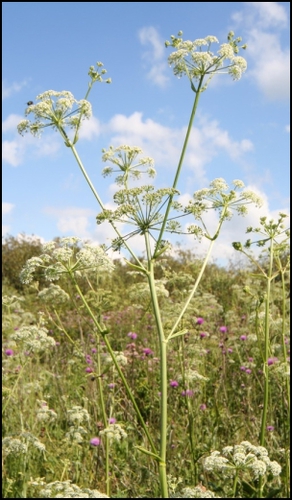Marsh Angelica
Angelica palustris
Its former scientific name “Ostericum” (in the past the name Ostericum palustre was used) is derived from the Greek word “hysterikos” – for its content of coumarins and essential oils the plant was used as a medicine in cases of hysteria or female difficulties. “Palustre” means marshy, thus characterizing the bond of this species to wetland habitats.
The Marsh Angelica is a stout (75-145 cm tall) biennial, seldom perennial plant from the Carrot family (Apiaceae). It flowers once in its lifetime, usually from June to September: small white flowers are arranged in compound umbels. From the similar but more common Angelica sylvetris it can be distinguished by slightly shiny, light green leaves with recurved segments.
 The main range of the Marsh Angelica extends from the eastern half of Europe to western Siberia, its western border runs through Central Europe. In Bohemia it occurred in only one site near Všetaty until the beginning of the 20th century. In Moravia there were originally six sites recorded, but in all of them the plant has disappeared. Currently it only occurs in one site near Hrdibořice (National Nature monument Hrdibořické rybníky - the Ponds of Hrdibořice), the occurrence having been discovered in the 1970s.
The main range of the Marsh Angelica extends from the eastern half of Europe to western Siberia, its western border runs through Central Europe. In Bohemia it occurred in only one site near Všetaty until the beginning of the 20th century. In Moravia there were originally six sites recorded, but in all of them the plant has disappeared. Currently it only occurs in one site near Hrdibořice (National Nature monument Hrdibořické rybníky - the Ponds of Hrdibořice), the occurrence having been discovered in the 1970s.
The sites´ decline has been caused by several impacts. First of all, it has been a disturbance of the water regime and ploughing. Other negative factors were application of chemicals and succession changes in the habitats. Small size of the residual population and a bad condition of the habitat have not allowed the species to spread naturally since the 1980s.
Because of that and also because of the species being endangered in the entire western and central European part of its range, an Action Plan for the Marsh Angelica was proposed. It was approved by the Ministry of the Environment of the Czech Republic in 2000 as the first Action Plan for plants.
